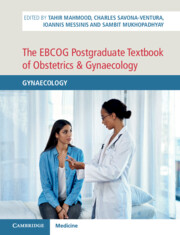Book contents
- The EBCOG Postgraduate Textbook of Obstetrics & Gynaecology
- The EBCOG Postgraduate Textbook of Obstetrics & Gynaecology
- Copyright page
- Dedication
- Contents
- Videos
- Contributors
- Preface
- Section 1 Basic Sciences in Gynaecology
- Section 2 Menstrual Disorders
- Chapter 6 Paediatric and Adolescent Gynaecology
- Chapter 7 Heavy Menstrual Bleeding
- Chapter 8 Management of Uterine Fibroids
- Chapter 9 Early-Onset Endometriosis
- Chapter 10 Chronic Pelvic Pain
- Section 3 Reproductive Endocrinology and Infertility
- Section 4 Contraception and STIs
- Section 5 Post-Reproductive Care
- Section 6 Vulva and Vagina
- Section 7 Cervix
- Section 8 Uterus
- Section 9 Ovary and Fallopian Tubes
- Section 10 Operative Gynaecology
- Section 11 Public Health Issues in Gynaecology
- Section 12 Miscellaneous
- Index
- Plate Section (PDF Only)
- References
Chapter 9 - Early-Onset Endometriosis
from Section 2 - Menstrual Disorders
Published online by Cambridge University Press: 24 November 2021
- The EBCOG Postgraduate Textbook of Obstetrics & Gynaecology
- The EBCOG Postgraduate Textbook of Obstetrics & Gynaecology
- Copyright page
- Dedication
- Contents
- Videos
- Contributors
- Preface
- Section 1 Basic Sciences in Gynaecology
- Section 2 Menstrual Disorders
- Chapter 6 Paediatric and Adolescent Gynaecology
- Chapter 7 Heavy Menstrual Bleeding
- Chapter 8 Management of Uterine Fibroids
- Chapter 9 Early-Onset Endometriosis
- Chapter 10 Chronic Pelvic Pain
- Section 3 Reproductive Endocrinology and Infertility
- Section 4 Contraception and STIs
- Section 5 Post-Reproductive Care
- Section 6 Vulva and Vagina
- Section 7 Cervix
- Section 8 Uterus
- Section 9 Ovary and Fallopian Tubes
- Section 10 Operative Gynaecology
- Section 11 Public Health Issues in Gynaecology
- Section 12 Miscellaneous
- Index
- Plate Section (PDF Only)
- References
Summary
Classically endometriosis develops sometime after menarche and has been reported in girls as early as 10 years. There is limited knowledge about early-onset endometriosis, particularly about disease progression and its effect on fertility. Patients often present with prevailing symptoms of dysmenorrhoea, cyclic or acyclical pelvic pain. NSAIDS and COCs are often used to treat non-specific nature of pelvic pain. Ultrasound is the first-line imaging modality but MRI offers better visualization of deep infiltrating endometriosis. A patient-centred approach with detailed explanation of treatment options incorporating the patient’s wishes should individualize the management plan. Medical treatment is the most preferred option and surgical intervention may be necessary in selected cases.
Keywords
- Type
- Chapter
- Information
- The EBCOG Postgraduate Textbook of Obstetrics & GynaecologyGynaecology, pp. 72 - 80Publisher: Cambridge University PressPrint publication year: 2021

